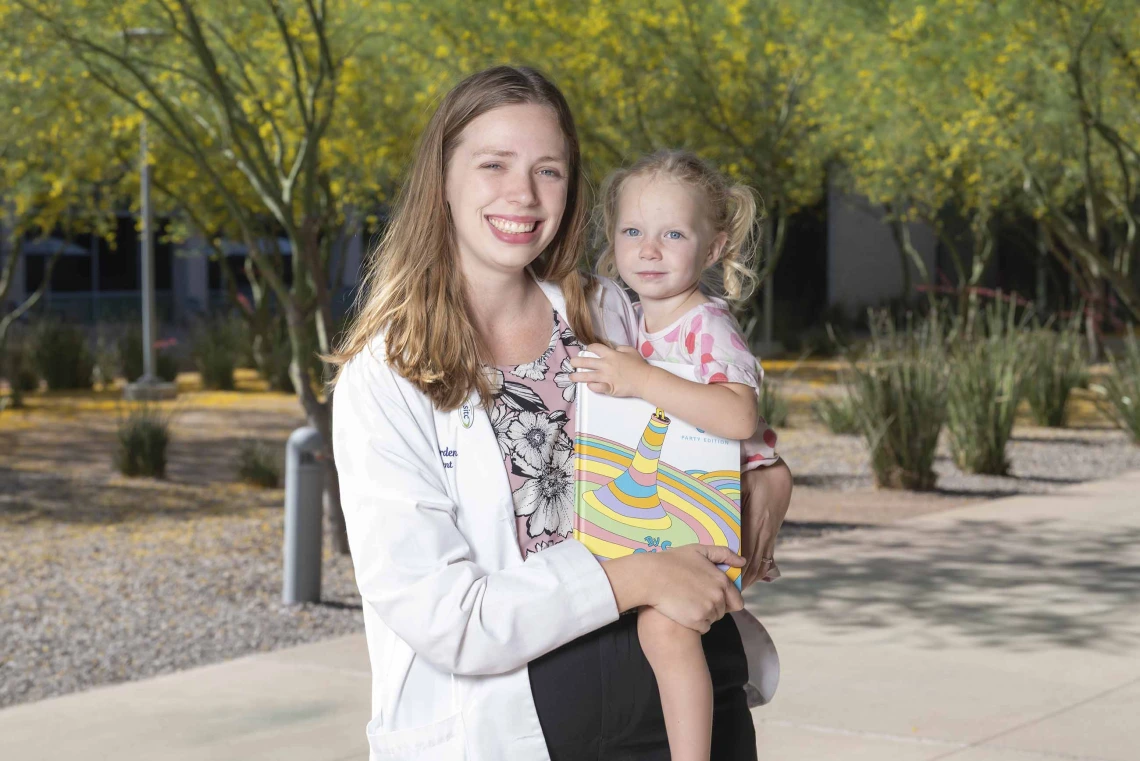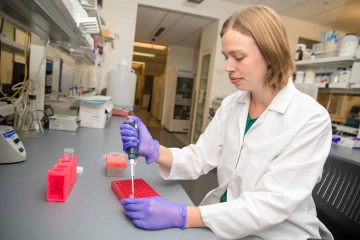Taking on cancer in the lab and at the clinic
Elizabeth Borden, PhD, is researching cancer vaccines while pursuing her goal of becoming a pediatric oncologist.

Medical student Elizabeth Borden, PhD, holding her 3-year-old daughter, Miriam, aspires to be a pediatric oncologist and cancer researcher.
Photo by Noelle Haro-Gomez, U of A Health Sciences Office of Communications
When U of A College of Medicine – Phoenix MD/PhD student Elizabeth Borden, PhD, finishes a long day of lab work, studying and clinical rotations, she makes a house call that is the highlight of her day. Borden’s 5-year-old son and 3-year-old daughter jump into her arms and quiz her about her day as she catches up with her husband.

Borden’s research contributed to her doctorate in clinical translational sciences. She is now on track to complete her medical degree.
Photo by Adam Brooks, U of A College of Medicine – Phoenix
The sense of togetherness reinforces to Borden why she works so hard to pursue her dream of becoming a physician-scientist.
“My kids really inspire me,” said Borden, who received her doctorate in clinical translational sciences from the University of Arizona College of Health Sciences in December and is on track to earn her Doctor of Medicine degree in 2027. “I try to show my kids how to work hard and do things that they’re passionate about. I hope they’re seeing me do that day in and day out.”
Borden’s daughter, Miriam, is already reflecting that vision. She often wears a toy stethoscope and pretends to give medical care to her dolls.
“She told me the other day that she was going to be a doctor just like me when she grows up.”
Borden said she always wanted to be a doctor, but her choice to pursue a medical degree and a doctorate at the same time stemmed from a moment of indecision.
“When I was an undergrad at Seattle Pacific University, I started doing research in computational chemistry and loved it. Then I started thinking, do I want to do science, or do I want to do medicine?” she said. “It was about two weeks before grad school applications were due, and I finally realized that I wanted both science and medicine in my future career.”
The MD/PhD program at the College of Medicine – Phoenix provided the ideal path for Borden, who plans to become a pediatric oncologist and cancer researcher. The clinical translational sciences doctorate program is meant to train students to be skilled researchers who can address clinical and basic science aspects of translational research. It fit perfectly into Borden’s master plan to connect lab research to improving patient outcomes in her medical practice.
“Working as a medical doctor will give me clear connection to the health outcomes of my patients, and having a clinic can drive the research questions I want to ask,” Borden said.
A new toolkit for answering questions
The questions Borden asks in the lab concentrate on how the immune system targets and kills cancer cells in the body. She found a mentor in Karen Hastings, MD, PhD, a professor and the chair of the Department of Dermatology at the College of Medicine – Phoenix.

Borden says she is inspired by her children, including 3-year old Miriam, who enjoys “playing doctor” with her mom.
Photo by Noelle Haro-Gomez, U of A Health Sciences Office of Communications
Borden joined Hastings’ lab and helped advance research on cutaneous squamous cell carcinoma, a cancer that develops in squamous cells, which are in the outer layer of the skin. Hastings’ lab is identifying new ways to use T cells – immune cells that can recognize and destroy diseased cells – to fight cancer. She says the end goal is to develop personalized, cancer-killing vaccines.
Borden leveraged her background in computational chemistry to bolster the lab’s research into neoantigens – unique antigens created by cancer mutations that serve as red flags for the immune system. Unlike normal antigens, neoantigens are able to be recognized by the immune system as threats.
Hastings explained that computational analysis requires asking the same questions using different approaches to ensure the consistency of results. Borden’s arrival brought a new level of understanding to the process.
“I was very impressed with Elizabeth when I first met her,” said Hastings, who is also a member of the U of A Cancer Center. “She opened the door to this new type of analysis. We had a much greater depth of understanding of the answers than if we had done a fee-for-service arrangement. It gave us a whole new toolkit to ask questions in immunology, and I really appreciated having that opportunity.”
Hastings helped Borden apply for the F30 fellowship training grant she received from the National Cancer Institute. The funding supported Borden’s computational work on cutaneous squamous cell carcinoma and immunoediting, a dynamic interaction between the immune system and cancer cells that shapes the tumor that ultimately forms.

Borden (front) reviews research data with mentor Karen Hastings, MD, PhD, (back).
Photo by Adam Brooks, U of A College of Medicine – Phoenix
Hastings and Borden looked at skin cancer samples from people with suppressed and active immune systems and compared the profiles of neoantigens, which are short protein fragments resulting from cancer-specific changes to a gene. The goal was to pinpoint differences in the neoantigen profile and identify the specific neoantigens that can signal the immune system to attack.
In complementary work, the researchers developed the “NeoScore,” a tool designed to find the best targets for personalized cancer vaccines and help determine which patients are likely to respond to immunotherapy. In the presence of cancer, the NeoScore helps predict which neoantigens will be most likely to trigger an immune response. Personalized vaccines then aim to train the immune system to specifically target cancer cells displaying these unique neoantigens.
With her doctorate complete, Borden is focusing on her medical school curriculum and clinical rotations, including a surgical rotation at Phoenix Children’s Hospital. She sees the experience as instrumental in her path to becoming a pediatric oncologist and physician-scientist.
Borden said the opportunity to interact with children dealing with cancer during her surgical rotation was fulfilling and emotionally impactful.
“I feel like working in a clinic puts a humanizing face on research,” she said. “When you’re in the clinic, you can see why it’s important to study what you do. In research, it’s easy to get bogged down in details. When you go back to the clinic, you realize that if you can design a vaccine that kills these cancers, it can save these kids’ lives.”
Experts
Elizabeth Borden, PhD
MD/PhD Student, U of A College of Medicine – Phoenix
Karen Taraszka Hastings, MD, PhD
Professor and Chair, Department of Dermatology, U of A College of Medicine – Phoenix
Professor, Department of Basic Medical Sciences, U of A College of Medicine – Phoenix
Professor, Department of Immunobiology, U of A College of Medicine – Tucson
Professor, Clinical Translational Sciences, U of A College of Health Sciences
Member, U of A Cancer Center, U of A Health Sciences
Contact
Phil Villarreal
U of A Health Sciences Office of Communications
520-403-1986, pvillarreal@arizona.edu

